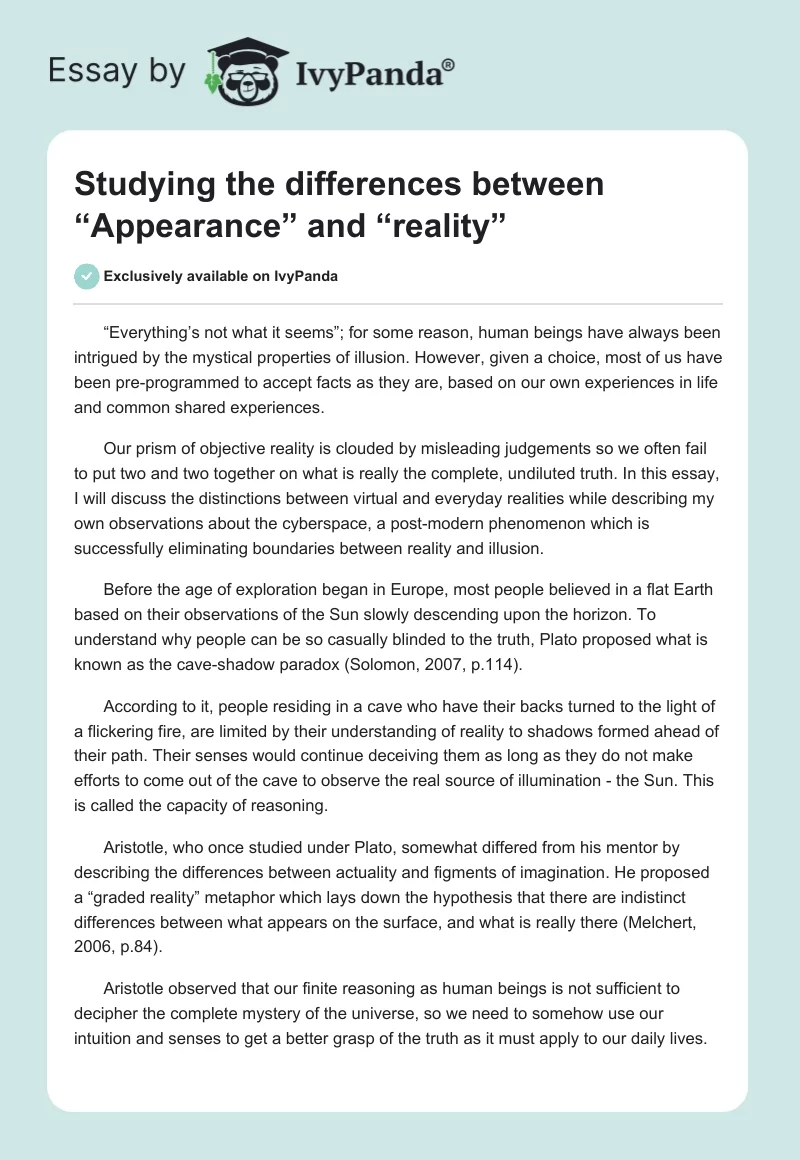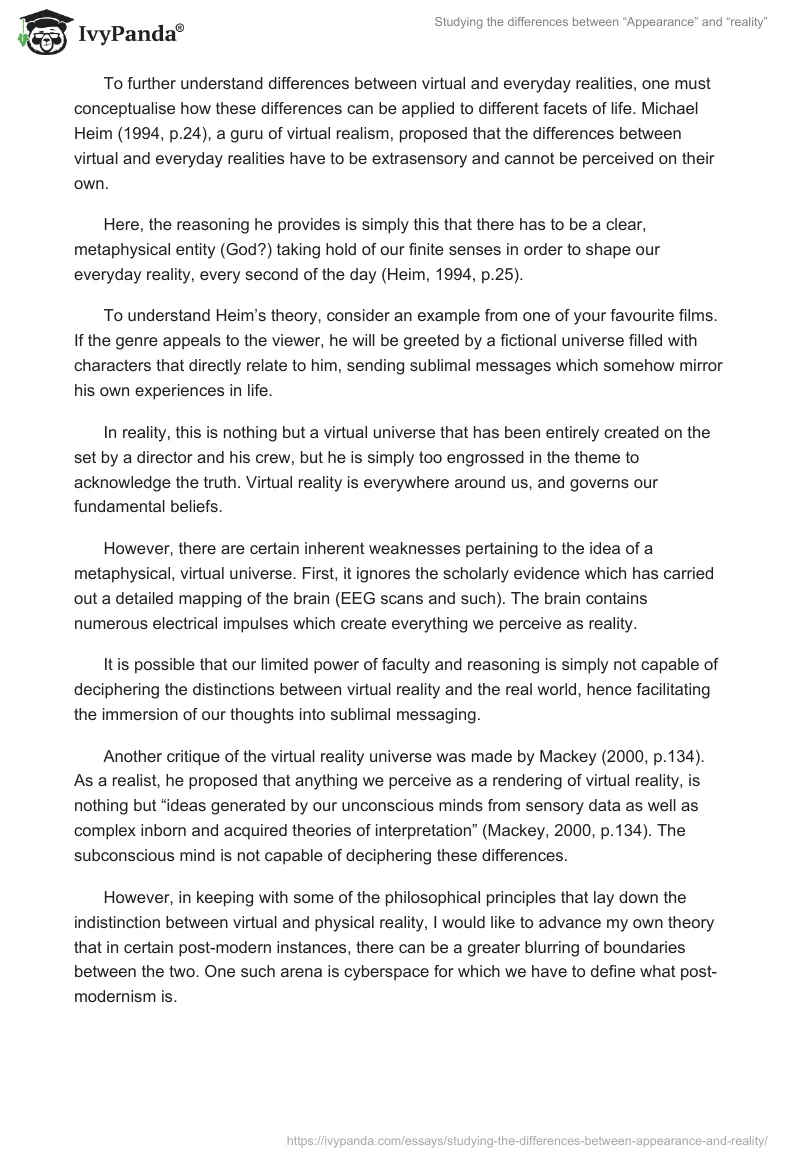“Everything’s not what it seems”; for some reason, human beings have always been intrigued by the mystical properties of illusion. However, given a choice, most of us have been pre-programmed to accept facts as they are, based on our own experiences in life and common shared experiences.
Our prism of objective reality is clouded by misleading judgements so we often fail to put two and two together on what is really the complete, undiluted truth. In this essay, I will discuss the distinctions between virtual and everyday realities while describing my own observations about the cyberspace, a post-modern phenomenon which is successfully eliminating boundaries between reality and illusion.
Before the age of exploration began in Europe, most people believed in a flat Earth based on their observations of the Sun slowly descending upon the horizon. To understand why people can be so casually blinded to the truth, Plato proposed what is known as the cave-shadow paradox (Solomon, 2007, p.114).
According to it, people residing in a cave who have their backs turned to the light of a flickering fire, are limited by their understanding of reality to shadows formed ahead of their path. Their senses would continue deceiving them as long as they do not make efforts to come out of the cave to observe the real source of illumination – the Sun. This is called the capacity of reasoning.
Aristotle, who once studied under Plato, somewhat differed from his mentor by describing the differences between actuality and figments of imagination. He proposed a “graded reality” metaphor which lays down the hypothesis that there are indistinct differences between what appears on the surface, and what is really there (Melchert, 2006, p.84).
Aristotle observed that our finite reasoning as human beings is not sufficient to decipher the complete mystery of the universe, so we need to somehow use our intuition and senses to get a better grasp of the truth as it must apply to our daily lives.
To further understand differences between virtual and everyday realities, one must conceptualise how these differences can be applied to different facets of life. Michael Heim (1994, p.24), a guru of virtual realism, proposed that the differences between virtual and everyday realities have to be extrasensory and cannot be perceived on their own.
Here, the reasoning he provides is simply this that there has to be a clear, metaphysical entity (God?) taking hold of our finite senses in order to shape our everyday reality, every second of the day (Heim, 1994, p.25).
To understand Heim’s theory, consider an example from one of your favourite films. If the genre appeals to the viewer, he will be greeted by a fictional universe filled with characters that directly relate to him, sending sublimal messages which somehow mirror his own experiences in life.
In reality, this is nothing but a virtual universe that has been entirely created on the set by a director and his crew, but he is simply too engrossed in the theme to acknowledge the truth. Virtual reality is everywhere around us, and governs our fundamental beliefs.
However, there are certain inherent weaknesses pertaining to the idea of a metaphysical, virtual universe. First, it ignores the scholarly evidence which has carried out a detailed mapping of the brain (EEG scans and such). The brain contains numerous electrical impulses which create everything we perceive as reality.
It is possible that our limited power of faculty and reasoning is simply not capable of deciphering the distinctions between virtual reality and the real world, hence facilitating the immersion of our thoughts into sublimal messaging.
Another critique of the virtual reality universe was made by Mackey (2000, p.134). As a realist, he proposed that anything we perceive as a rendering of virtual reality, is nothing but “ideas generated by our unconscious minds from sensory data as well as complex inborn and acquired theories of interpretation” (Mackey, 2000, p.134). The subconscious mind is not capable of deciphering these differences.
However, in keeping with some of the philosophical principles that lay down the indistinction between virtual and physical reality, I would like to advance my own theory that in certain post-modern instances, there can be a greater blurring of boundaries between the two. One such arena is cyberspace for which we have to define what post-modernism is.
Steinar Kavle (1992, p.20) supports the idea that extrasensory reality does exist because of a theory that rational thought has ignored the importance of factual information which cannot be interpreted by our conventional knowledge.
There is a lot of surreal beauty about intellectual thoughts which cannot be captured by the known senses alone. Kavle goes on to explain that the postmodern era frees the mind from orthodox opinions, and intrinsically promotes the advantage of freedom and independent thoughts (Kavle, 1992, p.21).
Cyberspace may be defined as the last frontier of human imagination – the Internets have unleashed a new wave of knowledge sharing and interaction skills that has been unprecedented in human history. The proliferation of social networking websites like Facebook, Twitter and more are forcing individuals to question their own rediscovery of the postmodern self; their real identities being juxtaposed with how they perceive themselves online.
The immersion of individuals with their cyberspace medium is so complete that scholars have started describing cyberspace as an alternative social reality (Introna, 1997, p.1). The author describes that in such a milieu, our conventional identities become plastic because we now have greater freedom to decide what we want from our lives when we participate in the medium of cyberspace and how it is possible to express ourselves ideally and what can be made out of these new identities.
Cooper (1995) underscored the importance of community participation to strengthen an individual’s affirmation of what he may perceive as his core defining values. The Internet, with its plethora of online interaction platforms, provides the best possible exposure to such individuals. They now have the freedom to network with multiple users in different corners of the Earth, exchange ideas and solidify their own reasoning and doubts. To further illustrate the impact of cyber-space on the shaping of realities, a few examples may be considered.
Online discussion forums such as Yahoo Answers, Community Live Journal, Straightdope and many more are seeing increasing participation from worldwide users who interact anonymously not only to share ideas, but to also debate, acknowledge each other and share things which may not hold true in real life.
Given that the online world allows you to be what you want to be, several forum posters lie about attributes which they feel define them even if it couldn’t be further from the truth. This includes age, sex, location, relationship status, hobbies, likes and dislikes and many more. Since, there is no way to tell the truth across the web, one has no option but to take their word for it.
There are also niche discussion forums which appeal to different categories of people: tourists, tattoo artistes, gardening enthusiasts, sports fans and more.
Many users utilize the interactivity of discussion forums to earn what are known as reputation points – the higher the reputation, the more established the user may be for that particular forum. At the end of the day, users continue fabricating a fictional universe for themselves which does not mirror the reality, thus, losing perspective on everyday matters, leading to a clear overlap of boundaries.
Apart from online discussion forums, MMORPG sites such as Second Life add another dimension of bewilderment to make users lose their grasp of reality. In this, users represent themselves through multiple role-playing avatars which enable them not only to play games, but also build a virtual world around they where they can be whatever they choose to be.
Common human failings such as a perception of attractiveness, an affinity for luxury goods and a sense of propriety come into play here. Users can own properties, buy weapons, fight with other users online and even date and romance each other (although, normally such users may not be attracted to each other in the real world).
In conclusion, it may be added that cyberspace represents the last frontier of human cognizance in a growing world of illusion. The continuous impressions generated by online role-playing sites can lead to an increased amount of confusion between the real and virtual worlds. The user’s grasp of reality in cyberspace is no more tenable than what it would have been had they been simply dreaming about it.
Reference List
Cooper, W., 1995. Virtual reality and the metaphysics of self, community and nature. International journal of applied philosophy, 9 (2).
Heim, M., 1994. The metaphysics of virtual reality. USA: Oxford University Press.
Introna, L., 1997. On cyberspace and being: identity, self and hyperreality. Philosophy in the contemporary world, 4 (1 & 2), pp.1-10
Kvale, S., 1992. Themes of postmodernity. New York: Sage Publications.
Mackey, J.P., 2000. The critique of theological reason. Cambridge, UK: Cambridge University Press.
Melchert, N., 2006. The great conversation: a historical introduction to philosophy. USA: Oxford University Press.
Solomon, R.C., 2007. Introducing philosophy: a text with integrated readings. 9th ed. USA: Oxford University Press.


